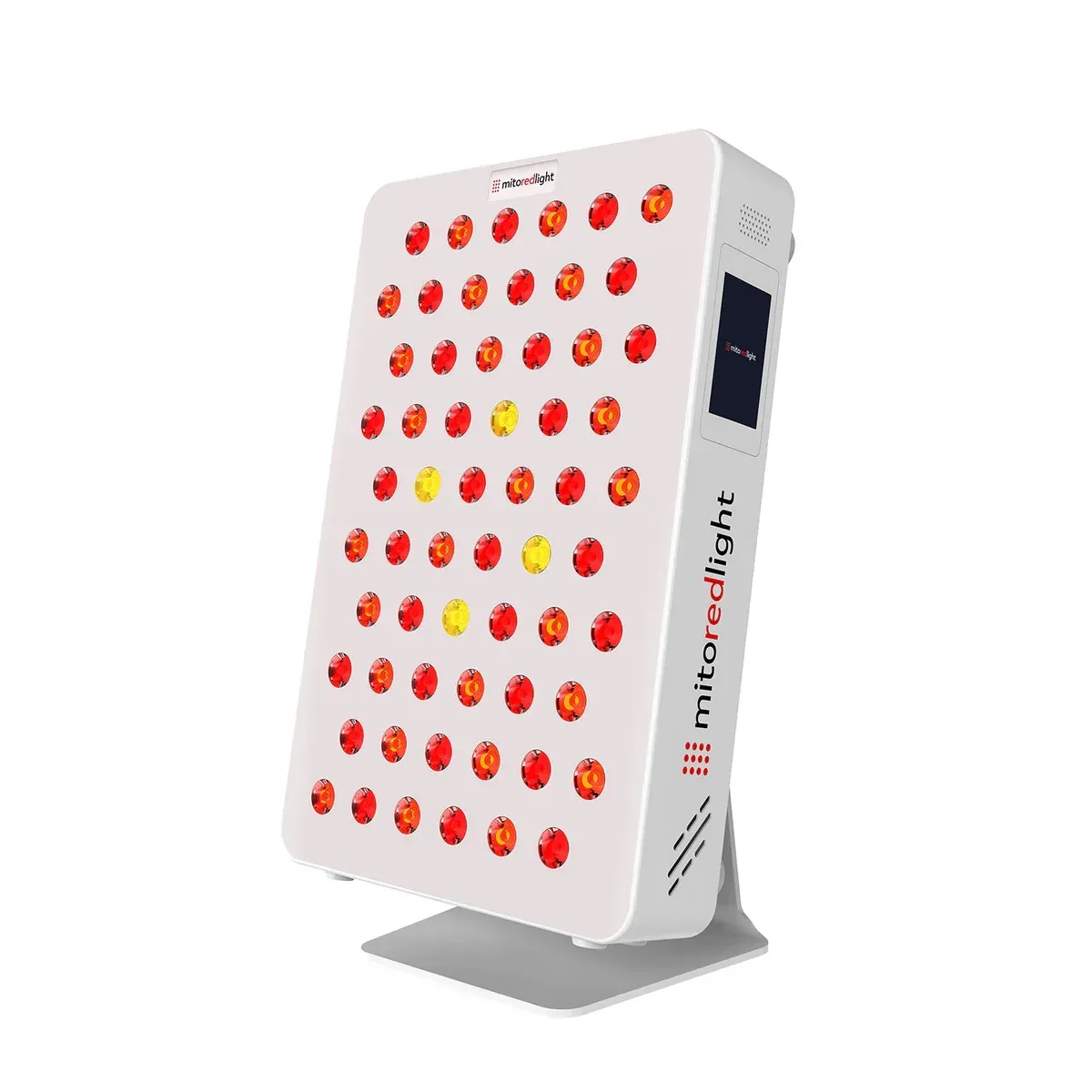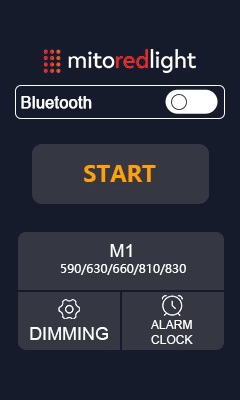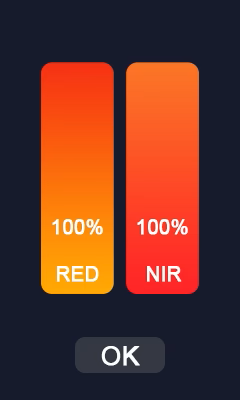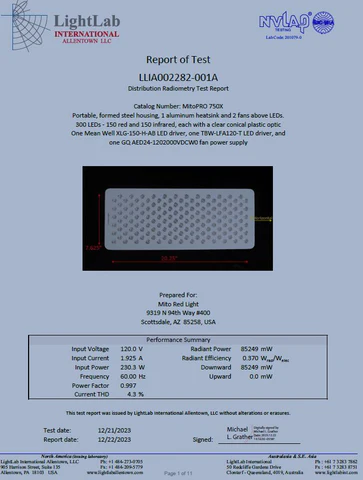
Introducing MitoPRO X: The Latest Advance In Red Light Therapy
What is Red Light Therapy?
Red light therapy is a therapeutic technique that uses low-wavelength red and infrared light. It has become increasingly popular in the health and wellness community due its many potential applications, ease of use and great safety profile. This form of therapy harnesses the power of specific light wavelengths that are believed to be absorbed by specific chemicals in the cells, improving their function and energy production. Red light therapy is known for its ability to stimulate collagen production, reduce inflammation, and accelerate the healing process among many other potential use cases.
For a deep dive into red light therapy and how it works read our article:
What Is Red and Near Infrared (NIR) Light Therapy?
The Science Behind Red Light Therapy
The effects of red light therapy were initially discovered by NASA scientists [1] during research into plant growth using red and infrared light. One accidental finding was that researchers who spent hours exposed to the light sources experienced noticeably faster healing of cuts and abrasions.
Since its initial discovery, there has been extensive research into how red light therapy works. Researchers believe these specific wavelengths of light influence cellular function by the impact on mitochondria [2], the microscopic powerhouses of each cell. Red light therapy is thought to enhance mitochondrial function by stimulating cytochrome C oxidase, a key enzyme in mitochondria that is sensitive to these wavelengths of light.
By absorbing specific wavelengths of red and near-infrared light, cytochrome C oxidase is believed to increase its activity, thereby boosting cellular energy production. This enhancement is what research believes causes many of the effects that people use red light therapy to achieve, effects like improved cell vitality, increased healing, and reduced inflammation.
Red light therapy is also thought to stimulate the release of nitric oxide, a critical signaling molecule involved in numerous physiological processes. Nitric oxide plays a role in vasodilation, blood flow regulation, and oxidative stress response. Red light therapy is thought to influence the release of nitric oxide from its binding sites within cytochrome C oxidase, leading to improved blood circulation, enhanced oxygen delivery to tissues, and better nutrient absorption at the cellular level.
The Need for New Innovations
As the interest in red light therapy grows, so does the demand for more advanced, efficient, and versatile Red light therapy devices. The market has seen a range of products, each aiming to offer something unique to meet the evolving needs of health-conscious consumers. This demand for innovation has led to the development of products like the MitoPRO X, which promises to redefine what we expect from red light therapy.
Unveiling the MitoPRO X
Amidst the expanding landscape of Red Light Therapy devices, the MitoPRO X emerges as a trailblazer, setting new benchmarks in the field. Complementing our award winning MitoPRO+ Series and the patent-pending 11 mode flexibility of the MitoADAPT 2.0 Series, the MitoPRO X is designed to cater to a wide array of needs, offering exceptional value, cutting-edge technology, design, power, flexibility and ease of use.

Product Overview
One of the standout new features of the MitoPRO X is its intuitive touchscreen interface. This feature allows you to easily control the device, customizing your therapy sessions to suit your individual needs. Whether it's adjusting the intensity, duration, or combination of specific wavelengths, the touch screen ensures a personalized and efficient experience.

Additionally, the MitoPRO X comes equipped with a built in clock and alarm function. This feature allows you to have the device turn on automatically at certain times of the day.
Set up a MitoPRO 300X on your nightstand and wake up to the soothing glow of red light in the morning! Set up a MitoPRO X in your work space and have the alarm turn on at certain times of the day to remind you take a few minute break, stand up, stretch or enjoy some red light therapy of course!

Another way the MitoPRO X improves the user experience is through its integration with the Mito Red Light app. You can control your device directly from your smart phone or tablet. The app also allows you to track your use and the benefits that you’ve seen, helping you to stay on track with your red light therapy plan and optimize it over time.
The app also give you access to unique modes such as NIR Extend and Interval mode. As new modes are launched, the app will automatically be updated expanding the ways you can use your device.
Technical Specifications
The MitoPRO X is not just about user experience; it's also about delivering powerful and unique red light therapy experience. At the heart of this device are the SIX wavelengths it offers:
590nm
630nm
660nm
810nm
830nm
850nm
These wavelengths have been carefully selected and mindfully apportioned based on the most recent research to provide a comprehensive range of benefits.
While the MitoPRO X contains six wavelengths, each LED package contains two large chips on separate circuits. This allows for the panel to be 100% Red (590,630,660) or 100% NIR (810.830,850) or 50% Red and 50% NIR.
Other products on the market that claim to have 'dual chip' LEDs use two small LED chips on the same circuit in the LED package under the focusing lens. In other words, both small chips will either be on or both chips will be off.
Mito Red pioneered the dual chip, dual circuit LED package design with our groundbreaking and patent-pending MitoADAPT 2.0 series.
This allows for high-intensity doses of light from all wavelengths and from every LED lens package despite the mode being used (Red only, NIR only or both together). As such, the MitoPRO X is not a 'watered down' multi-wavelength panel like some copycats that have emerged in the marketplace.
Speaking of multi-wavelengths, one new addition to our panel lineup is the inclusion of the 590nm wavelength. This wavelength, though used sparingly, marks a significant advancement and opens up new possibilities in terms of benefits - particularly in areas such as skin health and nitric oxide release.
The Science Behind 590nm
The inclusion of the 590nm wavelength in the MitoPRO X marks a significant advancement in our red light therapy devices, reflecting a deeper understanding of the potential benefits this particular wavelength could have on human health. This particular wavelength, although less commonly used in the past, holds a high level of potential, especially in the realms of dermatology and the cellular function of more superficial cells.
Why the 590nm Wavelength was added to the MitoPRO X
The decision to integrate the 590nm wavelength into the MitoPRO X was driven by emerging scientific research that highlights its unique benefits. This wavelength contains higher energy than other wavelengths of red light and borders orange and red light. Because of its higher energy, this wavelength of light does not penetrate as deeply into body tissues, making it most helpful for superficial tissues, especially the skin.
A study in Photobiomodulation, Photomedicine, and Laser Surgery using 590nm wavelength light found that this wavelength can help to delay the attrition of telomeres [6], a component of DNA related to aging. This protective effect could offer anti-aging benefits for the tissues this wavelength is used on. The 590nm wavelength is an excellent addition to a therapy device aimed at holistic health, as it complements the benefits provided by the more commonly used red and near-infrared wavelengths.
Benefits in Dermatology
The 590nm wavelength is most targeted towards dermatology applications. There are several studies examining the effects this wavelength has on the skin, and it has shown promising results in various studies. Research published in Skin Research & Technology indicates that this wavelength can aid in improving the structure and organization [7] of skin cells, improve skin tone, texture, and overall health. Its ability to stimulate collagen production makes it a powerful tool for anti-aging treatments, reducing wrinkles and fine lines.
A study in the Journal of Cosmetic Dermatology found that the use of the 590nm wavelength contributes to reducing redness of the skin [8] and promoting healing after sunburns. Other studies [9] in Lasers in Medical Science and Dermatologic Surgery showed that this wavelength improved wound healing [10] and reduced redness of the skin. Research published in Cells showed that the 590nm wavelength could help even out skin pigmentation [11] through its effects on specific skin cells.
Other important studies involving this wavelength include:
A 2005 study [12] published in Lasers in Surgery and Medicine that found 590nm light resulted in “smoother texture, reduction of peri-orbital rhytids, and reduction of erythema and pigmentation.”
Research published [13] in 2020 in Lasers in Medical Science that found that therapy using 590nm wavelengths could reduce the severity of skin damage when using radiation therapy to treat cancer.
A study [14] published in Annals of Translational Medicine in 2022 that used mouse research to demonstrate that 590nm light could reduce inflammation and redness in those with rosacea, a common skin condition that increases redness of the skin.
2022 research [15] published in Experimental Dermatology that demonstrated 590nm light could reduce oxidative stress and inflammation on skin cells exposed to damaging ultraviolet light
A 2023 study [16] published in Photobiomodulation, Photomedicine, and Laser Surgery which demonstrated a 30% reduction in wrinkles around the eyes after 10 sessions using 590nm and 660nm light combined.
Nitric Oxide Synthesis and its Effects
One of the most exciting aspects of the 590nm wavelength is its role in enhancing nitric oxide release [17] in cells. Nitric oxide is a crucial molecule in the human body, playing a vital role in various physiological processes, including blood circulation and immune response.
The stimulation of NO synthesis by the 590nm wavelength has far-reaching implications for health and wellness. By improving blood circulation [18], it can aid in delivering more oxygen and nutrients to cells, enhancing overall vitality and energy levels. This boost in circulation also contributes to better muscle recovery and reduced fatigue.
The ability to stimulate blood circulation through the release of nitric oxide also can contribute to overall energy levels and circulation and has even shown promising results [4] in helping with erectile dysfunction.
The incorporation of the 590nm wavelength in the MitoPRO X reflects a deep understanding of light therapy's potential to enhance holistic health. By harnessing the unique benefits of this wavelength, the MitoPRO X offers a more comprehensive and differentiated approach to red light therapy not found elsewhere.,
Broad Spectrum Approach to Wellbeing
While the inclusion of the 590nm wavelength is an important addition, one of the most valuable aspects the MitoPRO X offers is its inclusion of a broad spectrum of wavelengths - without diluting what we already know works!.
Holistic Effects of Broad Spectrum Therapy
The broad spectrum approach [3] in the MitoPRO X includes the option to use wavelengths ranging from the visible light spectrum (590nm, 630nm, and 660nm) to the near-infrared spectrum (810nm and 830nm). This diverse range of wavelengths allows the device to target various depths of the skin and tissue, each offering unique therapeutic benefits.
This approach can have two key benefits. The first is grounded in the principle of synergism - the idea that the combined effect of different wavelengths is greater than the sum of their individual effects. By covering a broader spectrum, the MitoPRO X is able to address a wider range of concerns simultaneously. For instance, while some wavelengths are more effective for surface skin issues, others penetrate deeper to aid muscle recovery and joint health.
The second key benefit to using a broad spectrum relates to the complex nuances of biological reactions. Changes in your body can result in different responses depending on a wide variety of variables. This can result in fluctuations in how the body responds to specific wavelengths of light at different times or even at the same time in different places on the body. Using a broad spectrum that includes multiple wavelengths, in theory can modulate this effect.
Comparing Broad-Spectrum Versus Traditional Systems
When comparing the broad-spectrum approach offered by the MitoPRO X to the more narrow options of traditional red light therapy systems, several key differences emerge. Traditional systems, while effective in their own right, are often limited by their focus on a narrow range of wavelengths.
In contrast, the broad-spectrum approach of the MitoPRO X offers a more versatile and comprehensive solution. By incorporating a wider range of wavelengths (but using TWO chips per lens package and therefore not losing out on a beneficial wavelength by simply replacing it with something else), the MitoPRO X has the potential to address a broader spectrum (pun intended) of concerns.
The broad-spectrum approach also aligns better with the growing understanding of holistic health, recognizing that the body's systems are interconnected and that comprehensive care often yields the best results. By offering a therapy that targets multiple points along the peak action spectra, the MitoPRO X offers a significant advance for those wanting to embrace truly innovative light therapy solutions.
We'd be remiss in not mentioning that broad spectrum is congruent with what we get from the sun! One of our foundational organizing principles is to let nature be thy guide.
Speaking of nature: the sun (our ancestral source of red and near infrared light therapy), has the largest amount of its visible spectrum residing in the vibrant yellow range. 30-35% of our daytime visible light is yellow. Perhaps some added yellow (590nm) into your day is not a bad idea after all!
Venturing Beyond 660nm and 850nm
Traditionally, red light therapy has primarily focused on the 660nm and 850nm peak LED wavelengths - this is primarily for economic reasons and not at all dictated by the strength of scientific evidence.
660nm and 850nm LED chips are used in other industries and are therefore easier to source and less expensive. Our goal is not to cut costs, but to build the best red light therapy devices on Planet Earth.
The inclusion of the carefully selected 'non-traditional' wavelengths in the MitoPRO X, such as 590nm, 630nm, 810nm and 830nm represents a significant advancement in light therapy that builds on simple foundational concepts.
If you have already heard of our incredibly popular and award winning MitoPRO+ Series, then you may be familiar with our reasoning for including 630nm and 830nm in the MitoPRO+ .Our aim was to better target the peak action spectra for the chromophore Cytochrome C Oxidase.

The MitoPRO X levels up from the MitoPRO+ by adding in a small amount of 590nm for enhanced skin and nitric oxide benefits while adding in 810nm for better penetration, among other benefits.
Futhermore the MitoPRO X contains two large chips on indvidual circuits under each lens (double the number of chips as the MitoPRO+) so the light panel can be made entirely red (590,630,660) entirely NIR (810/830/850) or 50% Red and 50% NIR.
Each peak LED wavelength in the MitoPRO X has been carefully selected and apportioned based on 1) our five years of experience in the industry, 2) feedback from thousands of customers and 3) the growing body of scientific research.
Each peak LED wavelength in the MitoPRO X has significant scientific backing and the combination yields a light therapy device that is much more than the sum of its parts. For example, while the 630nm wavelength is often used to improve skin health and healing, the properties of the 660nm wavelength [19] allow it to penetrate more effectively into deeper tissue, potentially offering healing and reducing inflammation that reaches areas the 630nm wavelength couldn’t reach. The 810nm [20] and 830nm wavelengths, falling in the near-infrared spectrum, penetrate even deeper, aiding in muscle recovery and joint health.
The addition of the 590nm wavelength, in particular, opens up new possibilities for helping conditions that were previously not as effectively addressed by other red light therapy options. Its unique properties make it a valuable tool in enhancing skin health and stimulating nitric oxide release, offering another layer of utility beyond the traditional red and near infrared wavelengths.
In the MitoPRO X, the 590nm is used sparingly, but sufficiently to create additive benefits to the very well established red and NIR wavelengths. Since most of the 590nm benefits are to be found in the skin, the power density need not be as high (compared to deep tissue where you require longer wavelengths AND higher power).
Potential Benefits
While research into red light therapy benefits is rapidly accumulating, the MitoPRO X, with its broad spectrum of wavelengths and the new addition of the 590nm wavelength, extends beyond traditional applications and offers a range of potential health benefits. These features make it a versatile choice for those wanting natural, holistic health options.
Skin Health
One of the most prominent benefits of the MitoPRO X is its impact on skin health [21]. The combination of wavelengths, particularly the inclusion of the 590nm wavelength, makes it an exceptional innovation in the area of skin-related concerns. The MitoPRO X employs wavelengths specifically selected to aid in improving skin tone, reducing signs of aging like fine lines and wrinkles, and enhancing overall skin appearance. It may also be beneficial for some inflammatory skin conditions like acne, rosacea, and eczema, providing a soothing effect and promoting healing.
Eye Health
Eye health is a relatively new area of exploration in red light therapy. Due to the sensitivity of the eyes to light, most red light experts don’t recommend using red light therapy on the eyes, even though there are no known harmful effects. Recent studies, however, have shown that specific wavelengths, like those included in the MitoPRO X, may help improve vision and protect against eye diseases. This has the potential to be particularly important in an age where screen time is high and eye strain is common.
Recent important studies in the area of eye health include:
A 2023 study [22] published in Retina that demonstrated some types of age-related macular degeneration may be improved by red light therapy.
A 2020 study [23] published in Trends in Molecular Medicine. This study did not address red light therapy but did identify problems in the mitochondria, the target of red light therapy, as a major component of retinal diseases.
A 2020 study [24] published in Retina that showed red light therapy was effective in treating dry age-related macular degeneration.
A 2023 study [25] published in Ophthalmology and Therapy that showed using light therapy (590nm, 660nm and 850nm) could help support treatments for non-exudative age-related macular degeneration.
Because Mito Red Lights are very bright we have always recommended wearing the provided red light therapy eye protection.
The good news about the MitoPRO X, is it comes with brightness control. Lowering the brightness setting down to 10-20% would be a gentle way to use the light on sensitive areas.

The research into how red light therapy affects eye health and any potential side effects is ongoing and it remains to be seen what potential red light therapy holds in this area.
Improved Circulation
Another health benefit that is thought to be related to the wavelengths of light used in the MitoPRO X is its ability to improve circulation [26]. The wavelengths are believed to be effective in stimulating blood flow, which is essential for overall health and vitality. Improved circulation not only aids in muscle recovery and reduces pain but also ensures that vital nutrients and oxygen are efficiently delivered throughout the body. This enhancement in blood flow has far-reaching effects, including better skin health, improved organ function, and a general sense of well-being.
Muscle Health
The wavelengths used in the MitoPRO X have been found to potentially impact muscle health [27], particularly for individuals engaged in physical activities or those experiencing muscle-related discomfort. These wavelengths penetrate deep into muscle tissues, aiding in reducing inflammation and muscle soreness. This can accelerate recovery times post-exercise and enhance muscle performance. Additionally, light therapy can support mitochondrial health in muscle cells, crucial for energy production and efficient muscle function.
Sleep Enhancement
Utilizing the MitoPRO X can also have a positive effect on sleep quality. The red and near-infrared wavelengths may help regulate the body's circadian rhythms, promoting a healthier sleep cycle. This is especially beneficial for those struggling with sleep disorders or irregular sleep patterns. Improved sleep not only enhances overall health but also supports cognitive functions, mood stabilization, and energy levels throughout the day. Studies support the idea that red light therapy contributes to improved duration and quality [28] of sleep.
Joint Health
Joint health is another area where the MitoPRO X shows promise. Therapy may be particularly beneficial for individuals with joint pain or conditions like arthritis. The wavelengths used by the MitoPRO X can penetrate joint tissues, helping to reduce inflammation and alleviate pain. This non-invasive approach can improve joint mobility and quality of life for those suffering from chronic joint issues, offering a natural and effective option for joint health maintenance.
Skin Health
For skin health [3], the MitoPRO X is designed to offer benefits like improved collagen production, reduction in fine lines and wrinkles, and enhanced skin tone and texture. The MitoPRO X includes several wavelengths that are thought to be ideal for skin health, including our all-new 590nm wavelength option. Whether you have a skin condition that could be helped by red light therapy, unsightly blemishes that you want treated, or simply want to keep your skin looking youthful, the MitoPRO X offers multiple combinations of the wavelengths that research suggests provide the best effect.
Cognitive Health
Cognitive health [5] is another area where the technology behind MitoPRO X shows promising results. Red light therapy has been used in studies to augment cognitive health in those with traumatic brain injuries, strokes, and other cognitive illnesses. Red light therapy has also been used to research improving the quality and duration of sleep and help augment overall health in ways that may have cognitive benefits.
Mito Red Light
The MitoPRO X is a significant advancement in red light therapy, offering a multifaceted approach to health and wellness. Its broad spectrum of wavelengths, including the innovative 590nm, provides comprehensive benefits that extend beyond traditional red light therapy devices. From enhancing skin health to improving circulation and overall well-being, the MitoPRO X offers an easy to use and holistic solution to anybody who wants to integrate red light therapy into their health and wellness routine.

Fluence Calculation:
Total Radiant Flux of 85,249 milliWatts = 85.2 Watts.
1 Watt = 1 Joule Per Second
So to calculate Joules in 10 minutes it is simply 85.2 Watts X 10 minutes X 60 seconds / minute = 51,120 Joules.
Surface Area of Panel = 1,392 square centimeters
51,120 Joules / 1,392 sq cm / 10 minutes = 3.7 J / cm2 / min
REFERENCES:
National Aeronautics and Space Administration. (2022, May 19). NASA Research Illuminates Medical Uses of Light. NASA Spinoff. https://spinoff.nasa.gov/NASA-Research-Illuminates-Medical-Uses-of-Light
Tafur, J., & Mills, P. J. (2008). Low-Intensity Light Therapy: Exploring the Role of Redox Mechanisms. Photomedicine and Laser Surgery, 26(4), 323–328. https://doi.org/10.1089/pho.2007.2184
Wunsch, A., & Matuschka, K. (2014). A Controlled Trial to Determine the Efficacy of Red and Near-Infrared Light Treatment in Patient Satisfaction, Reduction of Fine Lines, Wrinkles, Skin Roughness, and Intradermal Collagen Density Increase. Photomedicine and Laser Surgery, 32(2), 93–100. https://doi.org/10.1089/pho.2013.3616
Hotta, Y., Mori, T., & Kimura, K. (2022). A novel approach to treating erectile dysfunction with a light-controlled nitric oxide donor. Nihon Yakurigaku Zasshi, 157(3), 172–175. https://doi.org/10.1254/fpj.21112
Nizamutdinov, D., Ezeudu, C., Wu, E., Huang, J. H., & Yi, S. S. (2022). Transcranial near-infrared light in treatment of neurodegenerative diseases. Frontiers in Pharmacology, 13. https://doi.org/10.3389/fphar.2022.965788
Arabadjiev, B., Pankov, R., Vassileva, I., Petrov, L. S., & Buchvarov, I. (2020). Photobiomodulation with 590 nm Wavelength Delays the Telomere Shortening and Replicative Senescence of Human Dermal Fibroblasts In Vitro. Photobiomodulation, Photomedicine, and Laser Surgery, 38(11), 656-660. https://doi.org/10.1089/photob.2020.4822
Chabert, R., Fouque, L., Pinacolo, S., Garcia-Gimenez, N., Bonnans, M., Cucumel, K., & Domloge, N. (2015). Evaluation of light-emitting diodes (LED) effect on skin biology (in vitro study). Skin Research and Technology, 21(4), 426–436. https://doi.org/10.1111/srt.12210
Khoury, J. G., & Goldman, M. P. (2008). Use of light-emitting diode photomodulation to reduce erythema and discomfort after intense pulsed light treatment of photodamage. Journal of Cosmetic Dermatology, 7(1), 30-34. https://doi.org/10.1111/j.1473-2165.2008.00358.x
Alster, T. S., & Wanitphakdeedecha, R. (2009). Improvement of postfractional laser erythema with light-emitting diode photomodulation. Dermatologic Surgery, 35(5), 813-815. https://doi.org/10.1111/j.1524-4725.2009.01137.x
Wanitphakdeedecha, R., Iamphonrat, T., Phothong, W., Eimpunth, S., & Manuskiatti, W. (2019). Local and systemic effects of low-level light therapy with light-emitting diodes to improve erythema after fractional ablative skin resurfacing: a controlled study. Lasers in Medical Science, 34(2), 343-351. https://doi.org/10.1007/s10103-018-2599-1
Dai, X., Jin, S., Xuan, Y., Yang, Y., Lu, X., Wang, C., Chen, L., Xiang, L., & Zhang, C. (2022). 590 nm LED Irradiation Improved Erythema through Inhibiting Angiogenesis of Human Microvascular Endothelial Cells and Ameliorated Pigmentation in Melasma. Cells, 11(24), 3949. https://doi.org/10.3390/cells11243949
Weiss, R. A., McDaniel, D. H., Geronemus, R. G., & Weiss, M. A. (2005). Clinical trial of a novel non-thermal LED array for reversal of photoaging: clinical, histologic, and surface profilometric results. Lasers in Surgery and Medicine, 36(2), 85-91. https://doi.org/10.1002/lsm.20107
Park, J.-H., Byun, H. J., Lee, J. H., Kim, H., Noh, J. M., Kim, C. R., & Oh, D. (2020). Feasibility of photobiomodulation therapy for the prevention of radiodermatitis: A single-institution pilot study. Lasers in Medical Science, 35(5), 1119–1127. https://doi.org/10.1007/s10103-019-02930-1
Wu, S., Su, Y., Wang, L., Sun, B., & Jiang, X. (2022). The effects of photobiomodulation therapy on inflammatory mediators, immune infiltration, and angiogenesis in a mouse model of rosacea. Annals of Translational Medicine, 10(15), 831. https://doi.org/10.21037/atm-22-3204
Hong, J. Y., Han, H. S., Youn, J. H., Kim, H.-W., Ryu, H.-S., & Park, K. Y. (2022). Irradiation with 590-nm yellow light-emitting diode light attenuates oxidative stress and modulates UVB-induced change of dermal fibroblasts. Experimental Dermatology, 31(6), 931–935. https://doi.org/10.1111/exd.14542
Mota, L. R., Duarte, I. S., Galache, T. R., Pretti, K. M. D. S., Neto, O. C., Motta, L. J., Horliana, A. C. R. T., da Silva, D. F. T., & Pavani, C. (2023). Photobiomodulation Reduces Periocular Wrinkle Volume by 30%: A Randomized Controlled Trial. Photomedicine and Laser Surgery, 41(2), 48-56. https://doi.org/10.1089/photob.2022.0114
Quirk, B. J., & Whelan, H. T. (2020). What Lies at the Heart of Photobiomodulation: Light, Cytochrome C Oxidase, and Nitric Oxide-Review of the Evidence. Photobiomodulation, Photomedicine, and Laser Surgery, 38(9), 527-530. https://doi.org/10.1089/photob.2020.4905
Ball, K. A., Castello, P. R., & Poyton, R. O. (2011). Low intensity light stimulates nitrite-dependent nitric oxide synthesis but not oxygen consumption by cytochrome c oxidase: Implications for phototherapy. Journal of Photochemistry and Photobiology B: Biology, 102(3), 182-191. https://doi.org/10.1016/j.jphotobiol.2010.12.002
Nam, C. H., Park, B. C., Kim, M. H., Choi, E. H., & Hong, S. P. (2017). The Efficacy and Safety of 660 nm and 411 to 777 nm Light-Emitting Devices for Treating Wrinkles. Dermatologic Surgery, 43(3), 371-380. https://doi.org/10.1097/DSS.0000000000000981
Gupta, A., Dai, T., & Hamblin, M. R. (2014). Effect of red and near-infrared wavelengths on low-level laser (light) therapy-induced healing of partial-thickness dermal abrasion in mice. Lasers in Medical Science, 29(1), 257-265. https://doi.org/10.1007/s10103-013-1319-0
Mota, L. R., Motta, L. J., Duarte, I. S., Horliana, A. C. R. T., Silva, D. F. T. da, & Pavani, C. (2018). Efficacy of phototherapy to treat facial ageing when using a red versus an amber LED: a protocol for a randomised controlled trial. BMJ Open, 8(5), e021419. https://doi.org/10.1136/bmjopen-2017-021419
Benlahbib, M., Cohen, S. Y., Torrell, N., Colantuono, D., Crincoli, E., Amoroso, F., Semoun, O., Jung, C., & Souied, E. H. (2023). Photobiomodulation therapy for large soft drusen and drusenoid pigment epithelial detachment in age-related macular degeneration: A single-center prospective pilot study. Retina, 43(8), 1246-1254. https://doi.org/10.1097/IAE.0000000000003805
Ferrington, D. A., Fisher, C. R., & Kowluru, R. A. (2020). Mitochondrial Defects Drive Degenerative Retinal Diseases. Trends in Molecular Medicine, 26(1), 105-118. https://doi.org/10.1016/j.molmed.2019.10.008
Markowitz, S. N., Devenyi, R. G., Munk, M. R., Croissant, C. L., Tedford, S. E., Rückert, R., ... Tedford, C. E. (2020). A Double-Masked, Randomized, Sham-Controlled, Single-Center Study with Photobiomodulation for the Treatment of Dry Age-Related Macular Degeneration. Retina, 40(8), 1471–1482. https://doi.org/10.1097/IAE.0000000000002632
Burton, B., Battaglia Parodi, M., Jürgens, I., Zanlonghi, X., Hornan, D., Roider, J., Lorenz, K., Munk, M. R., Croissant, C. L., Tedford, S. E., Walker, M., Ruckert, R., & Tedford, C. E. (2023). LIGHTSITE II Randomized Multicenter Trial: Evaluation of Multiwavelength Photobiomodulation in Non-exudative Age-Related Macular Degeneration. Ophthalmology and Therapy, 12(2), 953–968. https://doi.org/10.1007/s40123-022-00640-6
Keszler, A., Lindemer, B., Weihrauch, D., Jones, D., Hogg, N., & Lohr, N. L. (2017). Red/Near Infrared Light Stimulates Release of an Endothelium Dependent Vasodilator and Rescues Vascular Dysfunction in a Diabetes Model. Free Radical Biology and Medicine, 113, 157–164. https://doi.org/10.1016/j.freeradbiomed.2017.09.012
Ferraresi, C., Huang, Y.-Y., & Hamblin, M. R. (2016). Photobiomodulation in human muscle tissue: An advantage in sports performance? Journal of Biophotonics, 9(11-12), 1273–1299. https://doi.org/10.1002/jbio.201600176
Zhao, J., Tian, Y., Nie, J., Xu, J., & Liu, D. (2012). Red Light and the Sleep Quality and Endurance Performance of Chinese Female Basketball Players. Journal of Athletic Training, 47(6), 673–678. https://doi.org/10.4085/1062-6050-47.6.08
DISCLAIMER: Mito Red Light devices are Class II wellness devices aimed at affecting the body through topical heating and supporting cellular function. The information provided in this article and on this site is for educational purposes only and is not intended to imply effectiveness of Mito Red Light devices for any specific application. The information provided in this article and on this site is not intended to diagnose, treat, cure, or prevent any disease, is not a substitute for consultation with a licensed medical provider and should not be construed as medical advice. Click here to read our article on potential contraindications of red light therapy..

